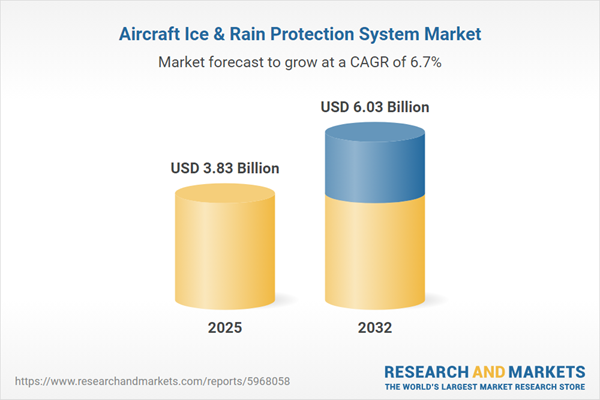Speak directly to the analyst to clarify any post sales queries you may have.
Aviation executives today face a landscape where evolving safety standards, compliance, and the demand for advanced protection systems all converge. Navigating this environment requires strategic investment in resilient solutions—not only to safeguard fleets, but also to maintain regulatory alignment as the aircraft ice and rain protection system market transforms.
Market Snapshot: Aircraft Ice and Rain Protection System Market Overview
The global aircraft ice and rain protection system market displays steady growth, moving from USD 3.59 billion in 2024 to USD 3.83 billion by 2025, and projected to reach USD 6.03 billion in 2032. With a CAGR of 6.69%, this market’s momentum is fueled by accelerated modernization across both civil and military aviation, integration of advanced protection technologies, and heightened regulatory scrutiny. This growth signals a pivot toward comprehensive, lifecycle-driven solutions and modernization programs that prioritize not only safety but future viability. Operators and suppliers must reassess capital deployment while enhancing system resilience across diverse environments and regulatory requirements. The aircraft ice and rain protection system market continues to demand executive attention as operational imperatives and technology converge.
Scope & Segmentation in the Aircraft Ice and Rain Protection System Market
- Technology: Chemical applications, electrothermal systems with automation benefits, adaptable hybrid designs, and proven pneumatic boot models all support reliable and effective ice removal, ensuring aircraft performance in challenging climates.
- Aircraft Type: Business jets, commercial narrow- and wide-body airplanes, general aviation units, and military aircraft each require tailored protections to fulfill mission needs and operate safely in varied conditions.
- Component: Engine inlets, propellers, windshields, and wing systems are safeguarded to ensure visibility and handling integrity, protecting both crew and assets from harsh weather.
- Installation: This market encompasses solutions for both OEM integration and aftermarket retrofit, allowing operators to align fleet protection with evolving compliance or modernization strategies throughout the aircraft lifecycle.
- End User: Commercial airlines, defense agencies, and MRO providers depend on robust protective systems to maintain flight safety and regulatory compliance during day-to-day operations.
- Regions: The Americas, Europe, and Asia-Pacific invest heavily in state-of-the-art protection due to colder climate exposure and rising climate unpredictability. Regional focus on upgrades is shaped by geography, policy, and local operational demands, making market participation critical for long-term competitiveness.
- Key Companies: Honeywell International Inc., Raytheon Technologies Corporation, Parker-Hannifin Corporation, Safran SA, Diehl Stiftung & Co. KG, Eaton Corporation plc, Crane Co., Moog Inc., Meggitt PLC, and General Electric Company set performance benchmarks and signal shifts in competitive landscape and technology adoption.
Key Takeaways for Senior Decision-Makers
- New materials and digital automation are enabling smoother system upgrades and greater ease of integration across both legacy and new aircraft.
- Lighter components and designs emphasizing energy efficiency support operator goals for compliance, cost management, and environmental stewardship.
- Modular architectures allow for scalable deployments, so fleets can remain adaptive as new regulation and technology updates are released.
- Real-time diagnostics and advanced predictive analytics improve maintenance, reduce unscheduled downtimes, and give managers enhanced visibility over operational risk.
- Maintaining strong relationships with suppliers provides agility in responding to shifts in policy and market dynamics, strengthening protection against supply interruptions.
Tariff Impact in 2025: Navigating Global Supply Chain Adjustments
With new U.S. tariffs on key raw materials and subsystem components, aviation organizations must rethink sourcing and logistics. There is a movement toward nearshoring, expanding supplier networks, and refining inventory processes. These adjustments support the continued rollout of next-generation systems while reducing exposure to delays and external disruptions. Proactive adaptation remains necessary to keep operational and technology upgrade schedules on track amid global uncertainty.
Methodology & Data Sources for Market Assessment
The market assessment incorporates in-depth secondary research, reviews of technical literature, and perspectives from aerospace engineers, supply chain professionals, and regulatory bodies. Patent analyses and academic publications provide foundational validation, ensuring the credibility and reliability of reported insights.
Why This Aircraft Ice and Rain Protection System Market Report Matters
- Equips aviation officers and compliance managers with up-to-date analysis for procurement, planning, and regulatory decision-making in a rapidly evolving industry.
- Highlights advancements in technology and supply chain strategy, supporting better long-term investment and operational planning.
- Offers insights to reinforce resilience and adaptation as regulatory and marketplace standards continue to change globally, ensuring executive readiness for market shifts.
Conclusion
By leveraging these findings, senior leaders can proactively address changing regulations, direct modernization investments, and ensure reliable operations in a dynamic aviation sector.
Additional Product Information:
- Purchase of this report includes 1 year online access with quarterly updates.
- This report can be updated on request. Please contact our Customer Experience team using the Ask a Question widget on our website.
Table of Contents
3. Executive Summary
4. Market Overview
7. Cumulative Impact of Artificial Intelligence 2025
Companies Mentioned
The companies profiled in this Aircraft Ice & Rain Protection System market report include:- Honeywell International Inc.
- Raytheon Technologies Corporation
- Parker-Hannifin Corporation
- Safran SA
- Diehl Stiftung & Co. KG
- Eaton Corporation plc
- Crane Co.
- Moog Inc.
- Meggitt PLC
- General Electric Company
Table Information
| Report Attribute | Details |
|---|---|
| No. of Pages | 194 |
| Published | October 2025 |
| Forecast Period | 2025 - 2032 |
| Estimated Market Value ( USD | $ 3.83 Billion |
| Forecasted Market Value ( USD | $ 6.03 Billion |
| Compound Annual Growth Rate | 6.6% |
| Regions Covered | Global |
| No. of Companies Mentioned | 11 |









